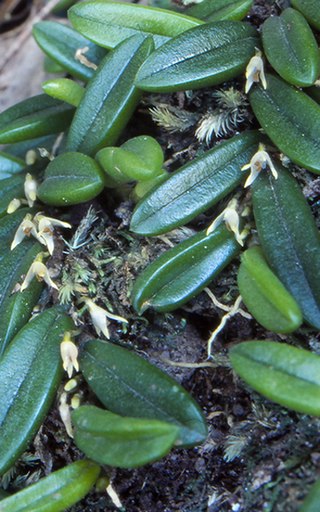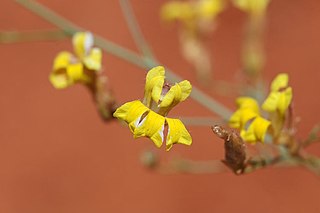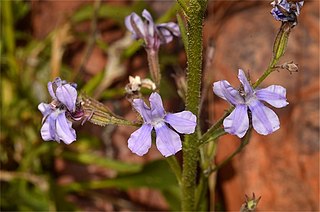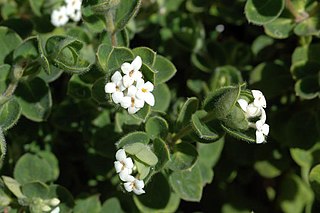
Bulbophyllum shepherdii, commonly known as the wheat-leaf rope orchid, is a species of epiphytic or lithophytic orchid that forms a dense mat of branching rhizomes pressed against the surface on which it grows. The pseudobulbs are well spaced along the rhizome, each with a single egg-shaped leaf and a single small, white or cream-coloured flower with yellow tips. It grows on trees and rocks in rainforest and is endemic to eastern Australia.

Pimelea congesta is a species of flowering plant in the family Thymelaeaceae and is endemic to Lord Howe Island in Australia. It is a shrub with rough bark, decussate, elliptic leaves and heads of white flowers.

Pimelea aeruginosa is a species of small shrub in the family Thymelaeaceae. It is a small shrub with yellow flowers and is endemic to Western Australia.

Goodenia azurea, commonly known as blue goodenia, is a species of flowering plant in the family Goodeniaceae and is endemic to northern Australia. It is an erect, dense, spreading or sprawling, glaucous, perennial herb with egg-shaped leaves with the narrower end towards the base, racemes or thyrses of bluish-purple flowers with leaf-like bracts, and oval to cylindrical fruit.

Goodenia calcarata, commonly known as streaked goodenia, is a species of flowering plant in the family Goodeniaceae and is endemic to Australia. It is an erect, annual herb with toothed egg-shaped to oblong leaves, racemes of white, cream-coloured or pink to mauve flowers with brownish markings, and oval fruit.
Goodenia goodeniacea is a species of flowering plant in the family Goodeniaceae and is endemic to northern, inland Australia. It a prostrate herb with toothed, elliptic to egg-shaped leaves at the base of the plant, and thyrses of yellow flowers with purplish lines.
Elaeocarpus grahamii is a species of flowering plant in the family Elaeocarpaceae and is endemic to north-east Queensland. It is a small to medium-sized tree, sometimes coppicing, with elliptic to egg-shaped leaves, flowers with five petals that have a frilled tip, and oval blue fruit.

Goodenia heterochila, commonly known as serrated goodenia, is a species of flowering plant in the family Goodeniaceae and is endemic to arid areas of Australia. It is an erect or ascending perennial herb with lance-shaped to egg-shaped stem leaves with the narrow end towards the base, and racemes of yellow flowers with a brownish centre.

Goodenia heteromera, commonly known as spreading goodenia or fan flower, is a species of flowering plant in the family Goodeniaceae and is endemic to south-eastern Australia. It is a perennial or annual, stolon-forming herb with lance-shaped to egg-shaped leaves with the narrow end towards the base, and racemes of yellow flowers with brownish markings.

Goodenia hirsuta is a species of flowering plant in the family Goodeniaceae and is endemic to northern Australia. It is a hairy, prostrate to low-lying perennial herb with narrow egg-shaped leaves at the base of the plant, racemes of hairy yellow flowers and oval to elliptic fruit.
Elaeocarpus ruminatus, commonly known as brown quandong, caloon or grey quandong, is a species of flowering plant in the family Elaeocarpaceae and is endemic to Queensland. It is a tree with buttress roots at the base of the trunk, mostly more or less elliptic leaves, cream-coloured flowers with five petals that sometimes have a divided tip, and more or less spherical fruit.

Goodenia lamprosperma is a species of flowering plant in the family Goodeniaceae and is endemic to northern Australia. It is an annual or perennial herb with linear to lance-shaped leaves sometimes with teeth on the edges, and racemes of yellow flowers.

Goodenia ramelii is a species of flowering plant in the family Goodeniaceae and is endemic to central Australia. It is a perennial herb with toothed, elliptic leaves in a rosette at the base of the plant, and racemes of blue flowers.

Pimelea altior is a species of flowering plant in the family Thymelaeaceae and is endemic to eastern Australia. It is a shrub with elliptic leaves and heads of white, tube-shaped flowers.
Pimelea concreta is a species of flowering plant in the family Thymelaeaceae and is native to northern Australia and parts of Indonesia. It is an annual herb with narrowly egg-shaped leaves and head-like clusters of white or pink, tube-shaped flowers surrounded by egg-shaped green involucral bracts.
Pimelea eyrei is a species of flowering plant in the family Thymelaeaceae and is endemic to the southwest of Western Australia. It is an erect shrub with hairy, narrowly elliptic leaves and clusters of densely hairy, white or cream-coloured flowers.
Pimelea forrestiana is a species of flowering plant in the family Thymelaeaceae and is endemic to Western Australia. It is a shrub with linear to narrowly elliptic leaves arranged in opposite pairs, and head-like clusters of yellow, tube-shaped flowers.
Pimelea leptospermoides, commonly known as serpentine rice flower, is a species of flowering plant in the family Thymelaeaceae and is endemic to Queensland. It is a shrub with narrowly egg-shaped to elliptic leaves and white, tube-shaped flowers arranged in groups of up to 7.
Pimelea sanguinea is a species of flowering plant in the family Thymelaeaceae and is endemic to northern Australia. It is a semi-prostrate herb with narrowly egg-shaped to almost linear leaves, and heads of red flowers surrounded by green or reddish, and deep reddish-purple involucral bracts.
Pimelea sericostachya is a species of flowering plant in the family Thymelaeaceae and is endemic to Queensland. It is an undershrub or shrub with densely hairy young stems, narrowly elliptic leaves, and heads of yellow or pale yellow flowers.












